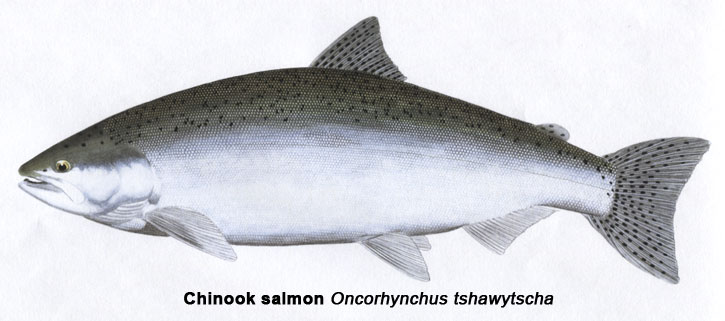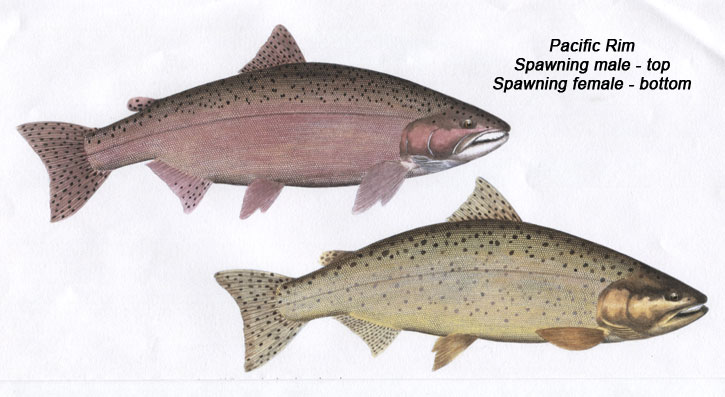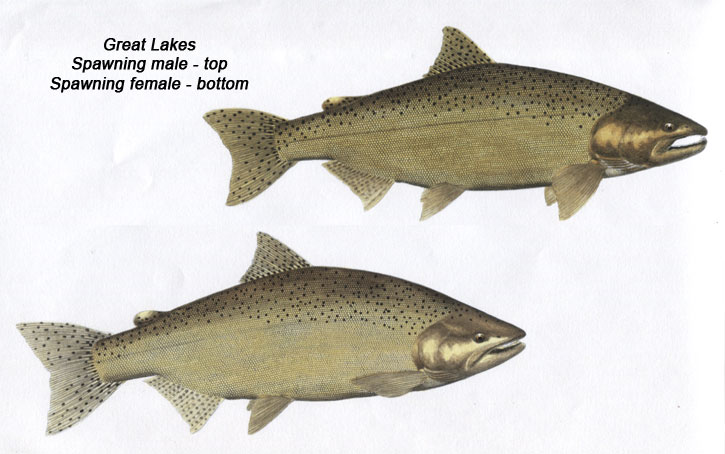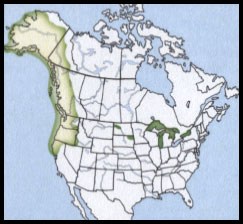Chinook Salmon, May 2012, Fish of the Month!


Chinook Salmon
Oncorhynchus tshawytscha
Local Names:
Blackmouth, Blackmouth salmon, Chinook, King, King salmon, Spring salmon, Quinnat, Tyee
Average Size:
24 - 36 inches
8 to 30 pounds
Distinguishing Field Marks:
Color and color pattern are reliable distinguishing field marks for this species. (See the illustration.)
-
Chinook salmon have black gums, distinguishing them from Coho salmon, which have gray or white gums.
-
Chinooks have narrow caudal peduncles which make them easy to lift with a hand grip at the bae of their tails. This is a reliable "field mark" that distinguishes Chinooks from Coho salmon and Steelhead.
-
The backs, dorsal, adipose, and both lobes of the tail have small black spots. Coho tails are only spotted on the top lobe.
-
The anal fin has a very long base, with 14 to 18 rays; longer at its base, and not so deep as that of the Coho.
North American Range:
Map to the right shows approximate range in North America.
Diet:
In fresh water Chinook salmon "smolts" feed exclusively on zooplankton and immature aquatic insects. Unlike other anadromous salmonids, Chinook salmon typically leave the rivers' estuaries when they are only 3 to 4 inches in length. Once in salt water or large lakes, they feed on whatever small foods are available. Ultimately, this largest of the North American salmons feeds primarily on fish, especially of those species that aggregate into dense schools, such as Alewife. Squid and shrimp make up the balance of the Chinook's at-sea or lake diet. Pacific salmon do not feed once they have re-entered their fresh water spawning streams.
Fly Fishing for Chinook Salmon:
Fly-fishers and Chinook salmon are unlikely to have close encounters until the salmon have left salt water or the large Great lakes on their spawning runs. Trolling large flies at the mouths of Chinook spawning streams may meet with some success. When the fish have gathered in these waters, casting large streamer flies may also pay off. But, the best fly fishing for these jumbo-size fish begins once the runs have actually entered fresh waters.
Do not bring a pea shooter on a water buffalo hunt. Interested in fly-roddong Chinooks? Leave your 5, 6, or 7 weight gear at home/camp. My Chinook fly rod choice from my personal fishing-gear closet? A 10 foot, 9/10 weight rod and reel. The reel I use holds plenty of backing too. For those of you coastal fly-rodders wondering about what you'll need for Chinook salmon fishing, that 10' 9/10 outfit also works well for Striped bass and Blufish.
What about flies? Well, in spite of the fact that these fish are not feeding in fresh water, they are aggressive. The males throw down the gauntlet right from the get-go. The females are nest-site shopping. Early in their up-stream runs, put a fly in the face of either males or females, and you're likely to get a response, sometimes that'll be a high-speed attack response, especially from the males. Look for aggressive Chinooks not in pools, but in resting slots in shallower riffle areas. Up-river, the most efficient way to connect is to find a comfortable sitting spot, take your seat, get relaxed, and wait 'til you see fish. Cast to those that stop, even briefly, on their up-stream push. A rule of thumb for your fly selection? Bigger, brighter, early on (in the lower parts of the river), smaller, darker (even natural-looking) the further up-stream you and the fish go. Chinooks will not rise far, if at all, in the water column to take your flies, so, you'll need to get them down. Although this author prefers short high-density, fast sinking "leaders," we'll leave the choice for getting your flies down to you. As always, check in with the locals (assuming you find one or more that'll give you real , not wild-goose-chase information) for fish location and fly choice. A few seasons in and you'll be your own local information source.
A conservation note from a local perspective here. When Pacific salmon were introduced to Lake Ontario in the 1950s, the Salmon River (the Lake's major eastern basin tribuary) was flow regulated by the power company's desire to grow its stock-holders' bottom line, not those of the fish and aquatic insect inhabitants of the river. The dam's gates would be opened and power would be generated. Then the gates would be closed, and the river would drop to a mere trickle. Not much was able to sucessfully reproduce under those conditions. About 20 years ago, minimum base flows were established, guaranteeing a year-round river. Back-in-the-day, it was assumed that, with little, if any, natural re-generating, the majority of salmonids would be "harvested" in Lake Ontario. In the spring of 2011, river-edge seining yielded enough river-spawned (not stocked) Chinook parr to extrapolate as many as 10,000,000 young-of-the year salmon getting ready to head out to the lake. In Pacific rim rivers that used to host Chinook runs every month of the year, the picture is not so bright. West coast Chinook salmon were, until their demise, the basis for the very survival of many native tribes. It's probably safe to assume that those days won't be back with us any time soon. Check and comply with all local, state, and provincial regulations whenever you wet line for these great fish. We, ladies and gentlemen, are this world's natural resource stock holders. It's not only the other guys' responsibilty to assure that there is a future for our favorite game fishes; it's ours.






